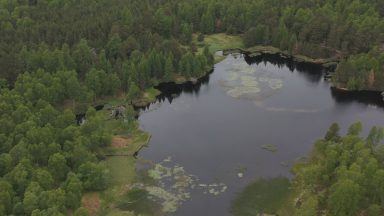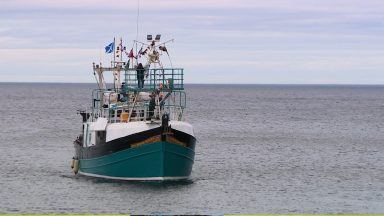There is growing opposition to giant electricity pylons that will stretch for 66 miles from Aberdeenshire to Angus through prime farmland.
At 180 feet high, the towering steel structures are the equivalent of more than 12 double decker buses stacked on top of each other.
Those living along the proposed route say they will fight to protect prime farmland and hope people power can force Scottish and Southern Energy to switch its plans.
But the energy giant said the development is vital to transmit green energy and fulfil net zero targets.
Ralph Young built his home 18 months ago in the peaceful, picturesque countryside near Edzell.
But the stunning scenery he looks out on could soon be spoiled by giant pylons.
“Financially, it obviously affects house prices, but for me, that’s not the most important thing.
“If we’re serious about tackling climate change which we absolutely should be, we shouldn’t be destroying the countryside to meet those targets,” said Ralph, who is a member of Angus Pylon Action Group.
“We should be offshoring, we should be looking at undergrounding, we should even be looking at existing pylons, can we upgrade them, can we replace them.”
Energy firm SSEN is planning a 66 mile power line from Kintore in Aberdeenshire to Fiddes where a new sub station will be built.
It will then skirt Catherun iron age hill forts in North Angus as it weaves its way down to Tealing, north of Dundee where a second sub station will be constructed.
The current pylons transmit 275 kilovolts of power but that will increase to 400 kilovolts.
The size of these so-called ‘super pylons’ will increase too.
They will dwarf the current structures, which are on average 118 feet high, and will be almost twice the height of the Kelpies.
The preferred route runs through the heart of the Howe of the Mearns, made famous by Lewis Grassic Gibbon in his classic novel Sunset Song.
Dorothy and Bill Clark, who now live in the writer’s historic childhood home, fear the development will destroy the area’s tranquillity.
“The peace and the quiet is going to go. We’re not going to get visitors who come to our self-catering which has a major impact. It’s just going to completely ruin our life here,” said Mrs Clark.
Farmer Shona Alexander is set to lose more than 100 acres of her land for one of the sub stations, making her farm unviable.
“Potentially we’re going to lose a third of our land at least,” she said.
“SSEN haven’t informed us how much of our farm they actually need because they need more for an access road and there could possibly be pylons on our land as well.
“If the sub station is going to be so close to our house, we’re not going to want to live there anymore, so potentially we could lose our home as well.”
Campaign groups have been set up in various communities along the preferred route.
Tracey Smith of the Save Our Mearns group says the uncertainty is causing a lot of worry.
She said: “It’s upsetting a lot of people. The mental health of some of the people who are on the preferred route or at the sub station is having a huge impact on them.
“There’s big concern where that will lead, because we are in the early stages of this consultation according to SSEN. But we are the people having to sit in limbo and wait to see what is going to happen.”
SSEN say the line is needed to meet energy security and climate change targets and stress no final decision has been made on the route.
Thomas Nicoll from SSEN Transmission said: “Projects like Kintore to Tealing are needed if we want to tackle climate change and hit the Scottish and UK governments net zero targets.
“Infrastructure like this is needed but we are very much in the early stages of development of this project and many others and we really want to hear from communities that have concerns about the projects that we are developing.”
A consultation has been extended until Friday July 28.
SSEN is investing £10bn to upgrade the network, connecting new onshore and offshore renewables generation in the north of Scotland so the power can be transported across the country.
A spokesperson for the energy firm said: “Once we progress to the development of potential route alignments, which is not expected until the end of the year at the earliest, we will work with those impacted to microsite tower locations to minimise and mitigate potential impacts on farming operations.
“We recognise that there may be impacts on farming and other businesses and can confirm that appropriate levels of compensation will be agreed in line with established industry practices, including for loss of earnings.
“It is important to reiterate that the project remains in the early stages of development and no specific overhead line route alignments have been identified. We would like to thank everyone who has shared their feedback so far, which will be carefully considered as we further refine our plans.”
Follow STV News on WhatsApp
Scan the QR code on your mobile device for all the latest news from around the country























